Cloud Migration: IaaS vs PaaS for Webb's Organization Report
VerifiedAdded on 2020/02/24
|7
|1499
|214
Report
AI Summary
This report analyzes the critical process of data migration to the cloud, a key strategy for organizations like Webb's aiming to modernize their operations. It focuses on two primary cloud service models: Infrastructure as a Service (IaaS) and Platform as a Service (PaaS). The report details the core differences between IaaS, which provides fundamental computing infrastructure, and PaaS, which offers a more comprehensive environment including operating systems and development tools. It presents a comparative analysis of the advantages and disadvantages of each model, considering factors such as flexibility, control, cost, and security. The report concludes with a recommendation for Webb's, suggesting the utilization of PaaS to facilitate strategy development and efficient software deployment. The report emphasizes the benefits of PaaS in terms of resource optimization and streamlined operations. The report references key sources to support its findings and recommendations.
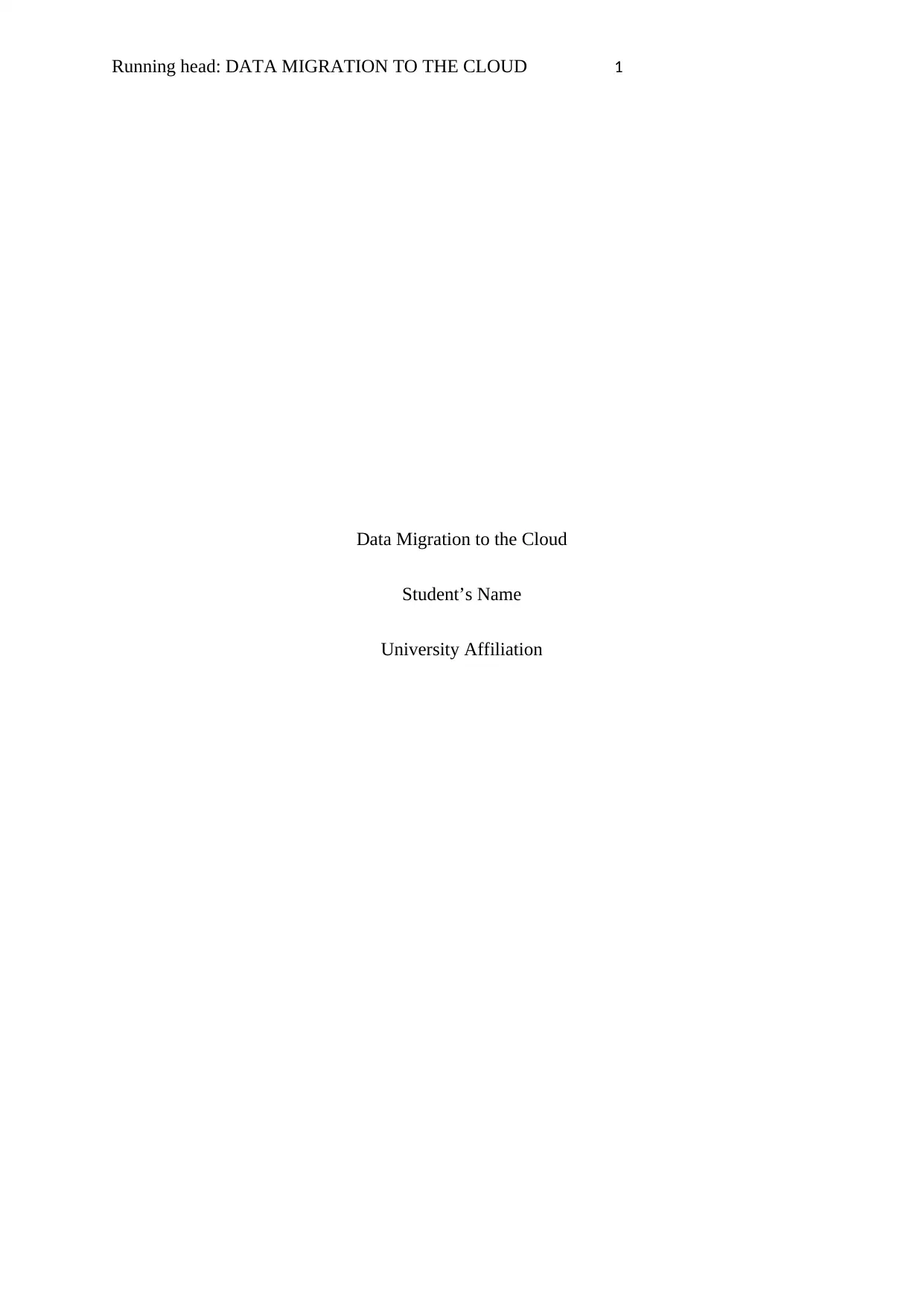
Running head: DATA MIGRATION TO THE CLOUD 1
Data Migration to the Cloud
Student’s Name
University Affiliation
Data Migration to the Cloud
Student’s Name
University Affiliation
Paraphrase This Document
Need a fresh take? Get an instant paraphrase of this document with our AI Paraphraser
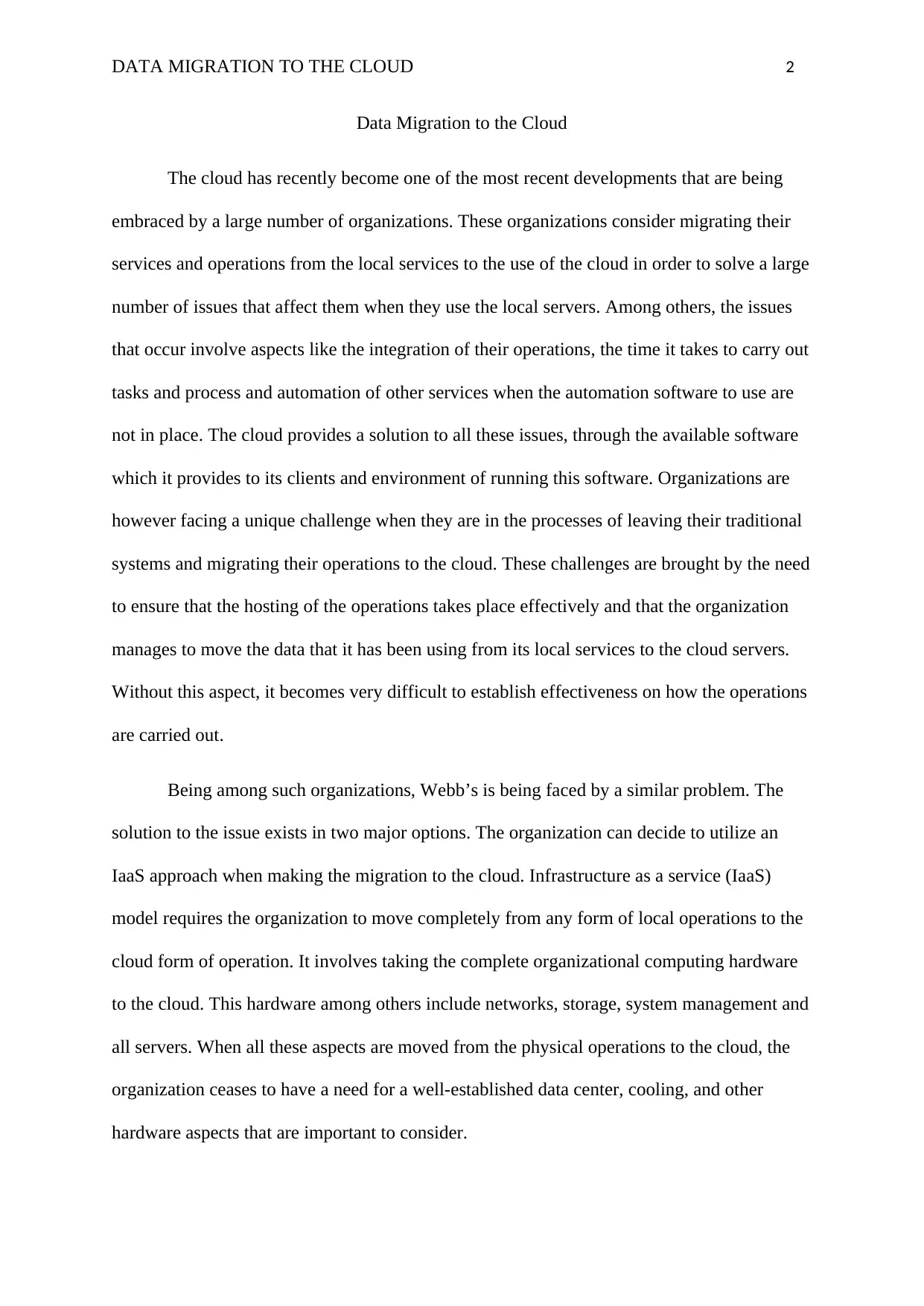
DATA MIGRATION TO THE CLOUD 2
Data Migration to the Cloud
The cloud has recently become one of the most recent developments that are being
embraced by a large number of organizations. These organizations consider migrating their
services and operations from the local services to the use of the cloud in order to solve a large
number of issues that affect them when they use the local servers. Among others, the issues
that occur involve aspects like the integration of their operations, the time it takes to carry out
tasks and process and automation of other services when the automation software to use are
not in place. The cloud provides a solution to all these issues, through the available software
which it provides to its clients and environment of running this software. Organizations are
however facing a unique challenge when they are in the processes of leaving their traditional
systems and migrating their operations to the cloud. These challenges are brought by the need
to ensure that the hosting of the operations takes place effectively and that the organization
manages to move the data that it has been using from its local services to the cloud servers.
Without this aspect, it becomes very difficult to establish effectiveness on how the operations
are carried out.
Being among such organizations, Webb’s is being faced by a similar problem. The
solution to the issue exists in two major options. The organization can decide to utilize an
IaaS approach when making the migration to the cloud. Infrastructure as a service (IaaS)
model requires the organization to move completely from any form of local operations to the
cloud form of operation. It involves taking the complete organizational computing hardware
to the cloud. This hardware among others include networks, storage, system management and
all servers. When all these aspects are moved from the physical operations to the cloud, the
organization ceases to have a need for a well-established data center, cooling, and other
hardware aspects that are important to consider.
Data Migration to the Cloud
The cloud has recently become one of the most recent developments that are being
embraced by a large number of organizations. These organizations consider migrating their
services and operations from the local services to the use of the cloud in order to solve a large
number of issues that affect them when they use the local servers. Among others, the issues
that occur involve aspects like the integration of their operations, the time it takes to carry out
tasks and process and automation of other services when the automation software to use are
not in place. The cloud provides a solution to all these issues, through the available software
which it provides to its clients and environment of running this software. Organizations are
however facing a unique challenge when they are in the processes of leaving their traditional
systems and migrating their operations to the cloud. These challenges are brought by the need
to ensure that the hosting of the operations takes place effectively and that the organization
manages to move the data that it has been using from its local services to the cloud servers.
Without this aspect, it becomes very difficult to establish effectiveness on how the operations
are carried out.
Being among such organizations, Webb’s is being faced by a similar problem. The
solution to the issue exists in two major options. The organization can decide to utilize an
IaaS approach when making the migration to the cloud. Infrastructure as a service (IaaS)
model requires the organization to move completely from any form of local operations to the
cloud form of operation. It involves taking the complete organizational computing hardware
to the cloud. This hardware among others include networks, storage, system management and
all servers. When all these aspects are moved from the physical operations to the cloud, the
organization ceases to have a need for a well-established data center, cooling, and other
hardware aspects that are important to consider.
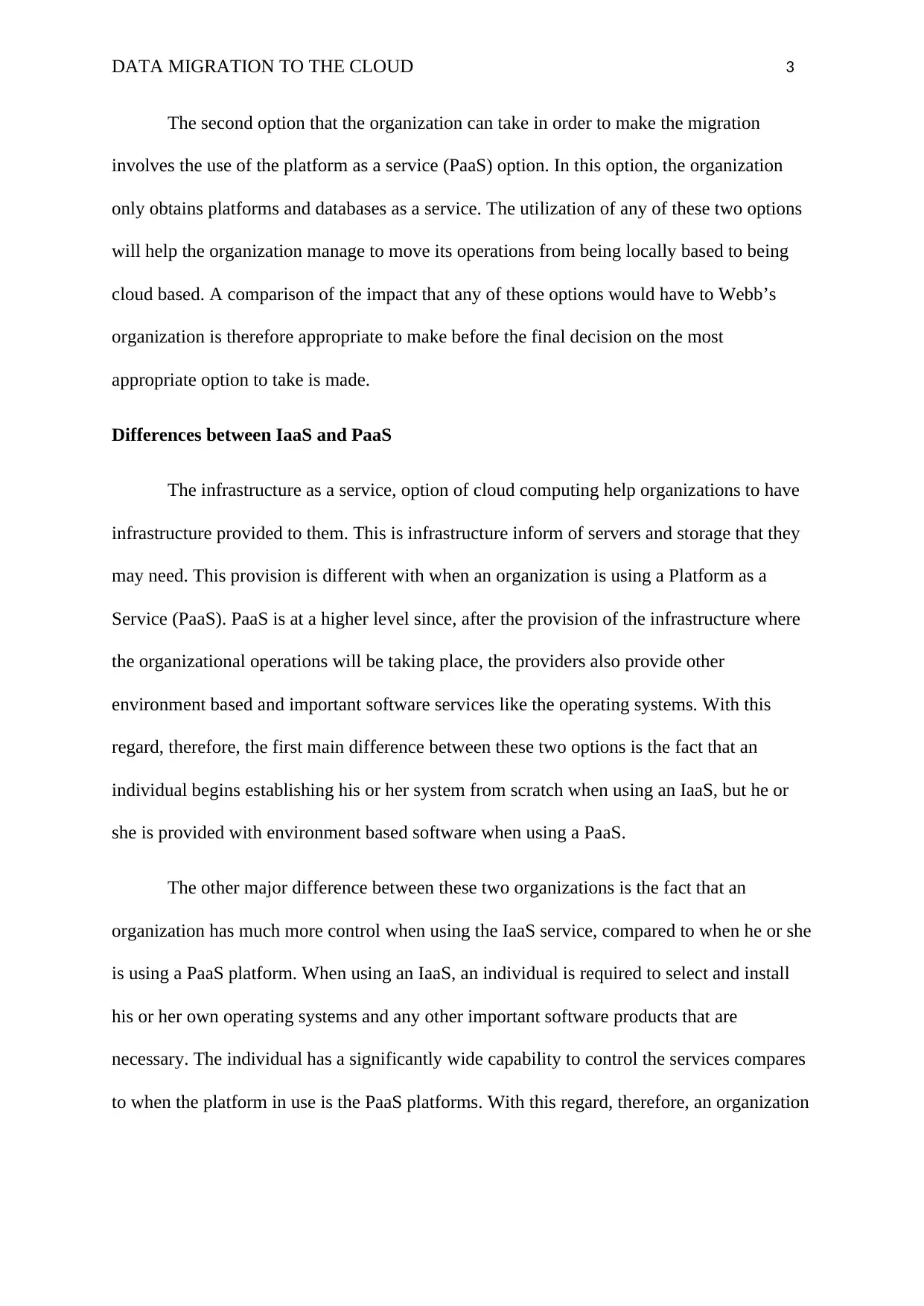
DATA MIGRATION TO THE CLOUD 3
The second option that the organization can take in order to make the migration
involves the use of the platform as a service (PaaS) option. In this option, the organization
only obtains platforms and databases as a service. The utilization of any of these two options
will help the organization manage to move its operations from being locally based to being
cloud based. A comparison of the impact that any of these options would have to Webb’s
organization is therefore appropriate to make before the final decision on the most
appropriate option to take is made.
Differences between IaaS and PaaS
The infrastructure as a service, option of cloud computing help organizations to have
infrastructure provided to them. This is infrastructure inform of servers and storage that they
may need. This provision is different with when an organization is using a Platform as a
Service (PaaS). PaaS is at a higher level since, after the provision of the infrastructure where
the organizational operations will be taking place, the providers also provide other
environment based and important software services like the operating systems. With this
regard, therefore, the first main difference between these two options is the fact that an
individual begins establishing his or her system from scratch when using an IaaS, but he or
she is provided with environment based software when using a PaaS.
The other major difference between these two organizations is the fact that an
organization has much more control when using the IaaS service, compared to when he or she
is using a PaaS platform. When using an IaaS, an individual is required to select and install
his or her own operating systems and any other important software products that are
necessary. The individual has a significantly wide capability to control the services compares
to when the platform in use is the PaaS platforms. With this regard, therefore, an organization
The second option that the organization can take in order to make the migration
involves the use of the platform as a service (PaaS) option. In this option, the organization
only obtains platforms and databases as a service. The utilization of any of these two options
will help the organization manage to move its operations from being locally based to being
cloud based. A comparison of the impact that any of these options would have to Webb’s
organization is therefore appropriate to make before the final decision on the most
appropriate option to take is made.
Differences between IaaS and PaaS
The infrastructure as a service, option of cloud computing help organizations to have
infrastructure provided to them. This is infrastructure inform of servers and storage that they
may need. This provision is different with when an organization is using a Platform as a
Service (PaaS). PaaS is at a higher level since, after the provision of the infrastructure where
the organizational operations will be taking place, the providers also provide other
environment based and important software services like the operating systems. With this
regard, therefore, the first main difference between these two options is the fact that an
individual begins establishing his or her system from scratch when using an IaaS, but he or
she is provided with environment based software when using a PaaS.
The other major difference between these two organizations is the fact that an
organization has much more control when using the IaaS service, compared to when he or she
is using a PaaS platform. When using an IaaS, an individual is required to select and install
his or her own operating systems and any other important software products that are
necessary. The individual has a significantly wide capability to control the services compares
to when the platform in use is the PaaS platforms. With this regard, therefore, an organization
⊘ This is a preview!⊘
Do you want full access?
Subscribe today to unlock all pages.

Trusted by 1+ million students worldwide
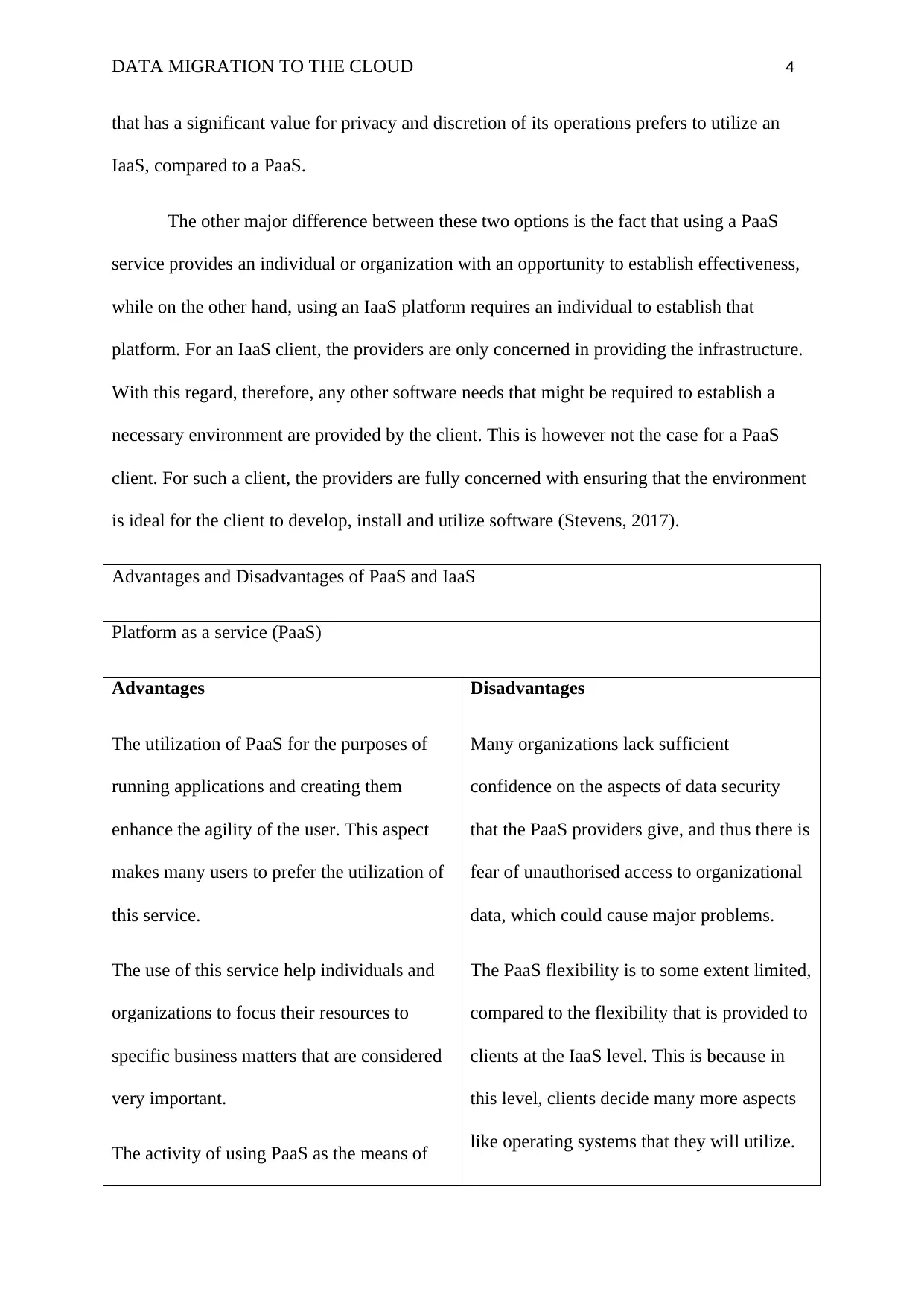
DATA MIGRATION TO THE CLOUD 4
that has a significant value for privacy and discretion of its operations prefers to utilize an
IaaS, compared to a PaaS.
The other major difference between these two options is the fact that using a PaaS
service provides an individual or organization with an opportunity to establish effectiveness,
while on the other hand, using an IaaS platform requires an individual to establish that
platform. For an IaaS client, the providers are only concerned in providing the infrastructure.
With this regard, therefore, any other software needs that might be required to establish a
necessary environment are provided by the client. This is however not the case for a PaaS
client. For such a client, the providers are fully concerned with ensuring that the environment
is ideal for the client to develop, install and utilize software (Stevens, 2017).
Advantages and Disadvantages of PaaS and IaaS
Platform as a service (PaaS)
Advantages
The utilization of PaaS for the purposes of
running applications and creating them
enhance the agility of the user. This aspect
makes many users to prefer the utilization of
this service.
The use of this service help individuals and
organizations to focus their resources to
specific business matters that are considered
very important.
The activity of using PaaS as the means of
Disadvantages
Many organizations lack sufficient
confidence on the aspects of data security
that the PaaS providers give, and thus there is
fear of unauthorised access to organizational
data, which could cause major problems.
The PaaS flexibility is to some extent limited,
compared to the flexibility that is provided to
clients at the IaaS level. This is because in
this level, clients decide many more aspects
like operating systems that they will utilize.
that has a significant value for privacy and discretion of its operations prefers to utilize an
IaaS, compared to a PaaS.
The other major difference between these two options is the fact that using a PaaS
service provides an individual or organization with an opportunity to establish effectiveness,
while on the other hand, using an IaaS platform requires an individual to establish that
platform. For an IaaS client, the providers are only concerned in providing the infrastructure.
With this regard, therefore, any other software needs that might be required to establish a
necessary environment are provided by the client. This is however not the case for a PaaS
client. For such a client, the providers are fully concerned with ensuring that the environment
is ideal for the client to develop, install and utilize software (Stevens, 2017).
Advantages and Disadvantages of PaaS and IaaS
Platform as a service (PaaS)
Advantages
The utilization of PaaS for the purposes of
running applications and creating them
enhance the agility of the user. This aspect
makes many users to prefer the utilization of
this service.
The use of this service help individuals and
organizations to focus their resources to
specific business matters that are considered
very important.
The activity of using PaaS as the means of
Disadvantages
Many organizations lack sufficient
confidence on the aspects of data security
that the PaaS providers give, and thus there is
fear of unauthorised access to organizational
data, which could cause major problems.
The PaaS flexibility is to some extent limited,
compared to the flexibility that is provided to
clients at the IaaS level. This is because in
this level, clients decide many more aspects
like operating systems that they will utilize.
Paraphrase This Document
Need a fresh take? Get an instant paraphrase of this document with our AI Paraphraser
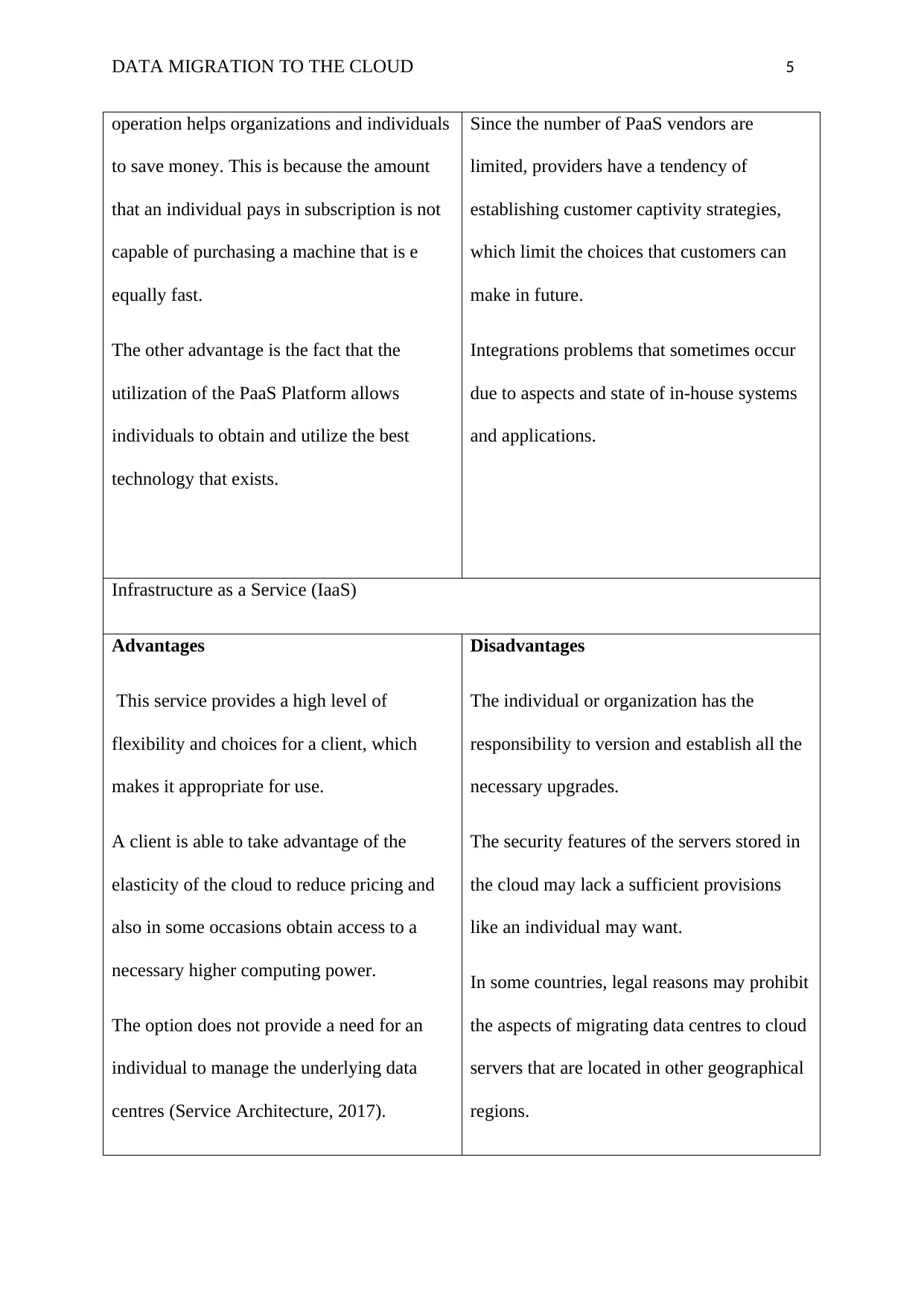
DATA MIGRATION TO THE CLOUD 5
operation helps organizations and individuals
to save money. This is because the amount
that an individual pays in subscription is not
capable of purchasing a machine that is e
equally fast.
The other advantage is the fact that the
utilization of the PaaS Platform allows
individuals to obtain and utilize the best
technology that exists.
Since the number of PaaS vendors are
limited, providers have a tendency of
establishing customer captivity strategies,
which limit the choices that customers can
make in future.
Integrations problems that sometimes occur
due to aspects and state of in-house systems
and applications.
Infrastructure as a Service (IaaS)
Advantages
This service provides a high level of
flexibility and choices for a client, which
makes it appropriate for use.
A client is able to take advantage of the
elasticity of the cloud to reduce pricing and
also in some occasions obtain access to a
necessary higher computing power.
The option does not provide a need for an
individual to manage the underlying data
centres (Service Architecture, 2017).
Disadvantages
The individual or organization has the
responsibility to version and establish all the
necessary upgrades.
The security features of the servers stored in
the cloud may lack a sufficient provisions
like an individual may want.
In some countries, legal reasons may prohibit
the aspects of migrating data centres to cloud
servers that are located in other geographical
regions.
operation helps organizations and individuals
to save money. This is because the amount
that an individual pays in subscription is not
capable of purchasing a machine that is e
equally fast.
The other advantage is the fact that the
utilization of the PaaS Platform allows
individuals to obtain and utilize the best
technology that exists.
Since the number of PaaS vendors are
limited, providers have a tendency of
establishing customer captivity strategies,
which limit the choices that customers can
make in future.
Integrations problems that sometimes occur
due to aspects and state of in-house systems
and applications.
Infrastructure as a Service (IaaS)
Advantages
This service provides a high level of
flexibility and choices for a client, which
makes it appropriate for use.
A client is able to take advantage of the
elasticity of the cloud to reduce pricing and
also in some occasions obtain access to a
necessary higher computing power.
The option does not provide a need for an
individual to manage the underlying data
centres (Service Architecture, 2017).
Disadvantages
The individual or organization has the
responsibility to version and establish all the
necessary upgrades.
The security features of the servers stored in
the cloud may lack a sufficient provisions
like an individual may want.
In some countries, legal reasons may prohibit
the aspects of migrating data centres to cloud
servers that are located in other geographical
regions.
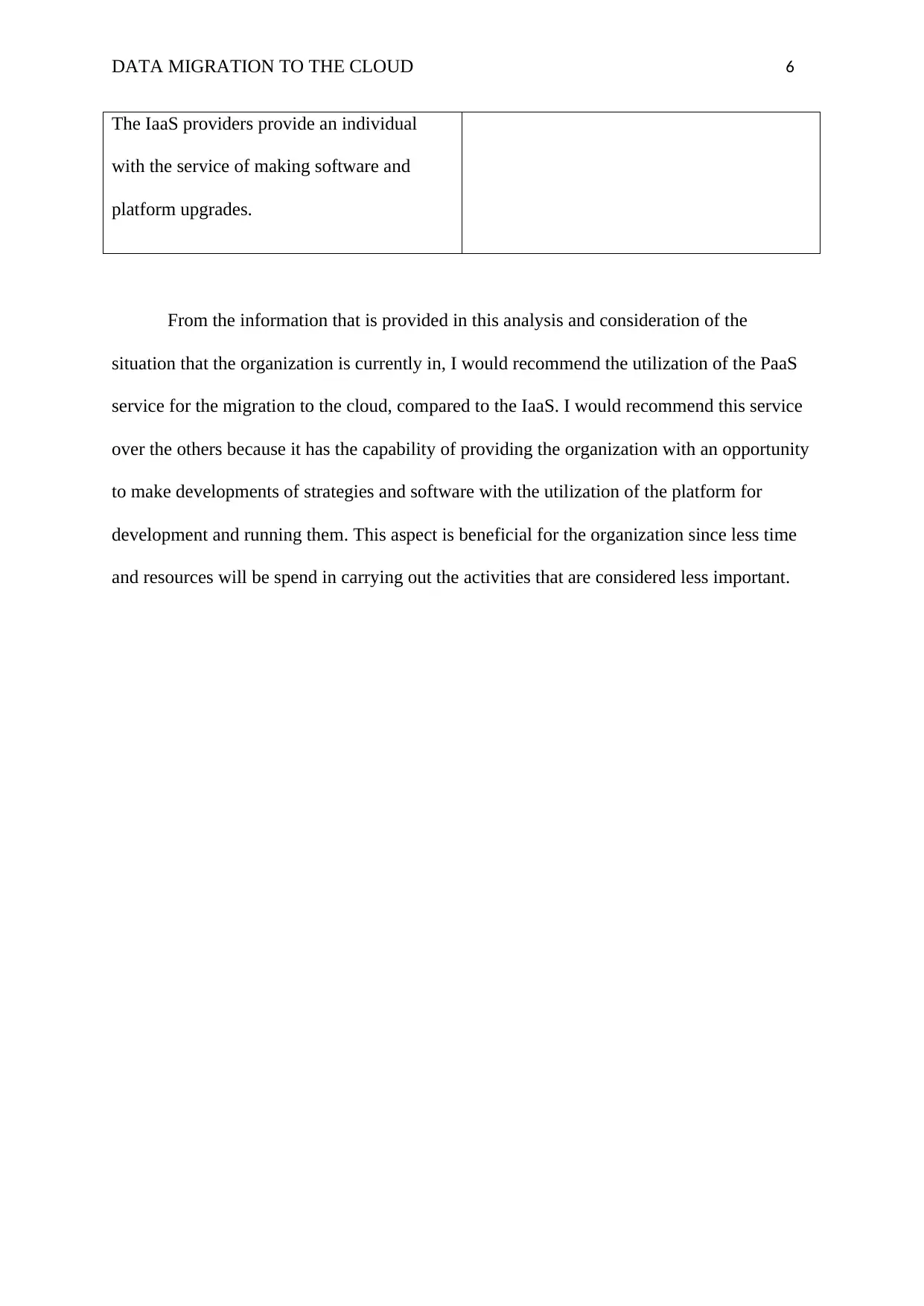
DATA MIGRATION TO THE CLOUD 6
The IaaS providers provide an individual
with the service of making software and
platform upgrades.
From the information that is provided in this analysis and consideration of the
situation that the organization is currently in, I would recommend the utilization of the PaaS
service for the migration to the cloud, compared to the IaaS. I would recommend this service
over the others because it has the capability of providing the organization with an opportunity
to make developments of strategies and software with the utilization of the platform for
development and running them. This aspect is beneficial for the organization since less time
and resources will be spend in carrying out the activities that are considered less important.
The IaaS providers provide an individual
with the service of making software and
platform upgrades.
From the information that is provided in this analysis and consideration of the
situation that the organization is currently in, I would recommend the utilization of the PaaS
service for the migration to the cloud, compared to the IaaS. I would recommend this service
over the others because it has the capability of providing the organization with an opportunity
to make developments of strategies and software with the utilization of the platform for
development and running them. This aspect is beneficial for the organization since less time
and resources will be spend in carrying out the activities that are considered less important.
⊘ This is a preview!⊘
Do you want full access?
Subscribe today to unlock all pages.

Trusted by 1+ million students worldwide
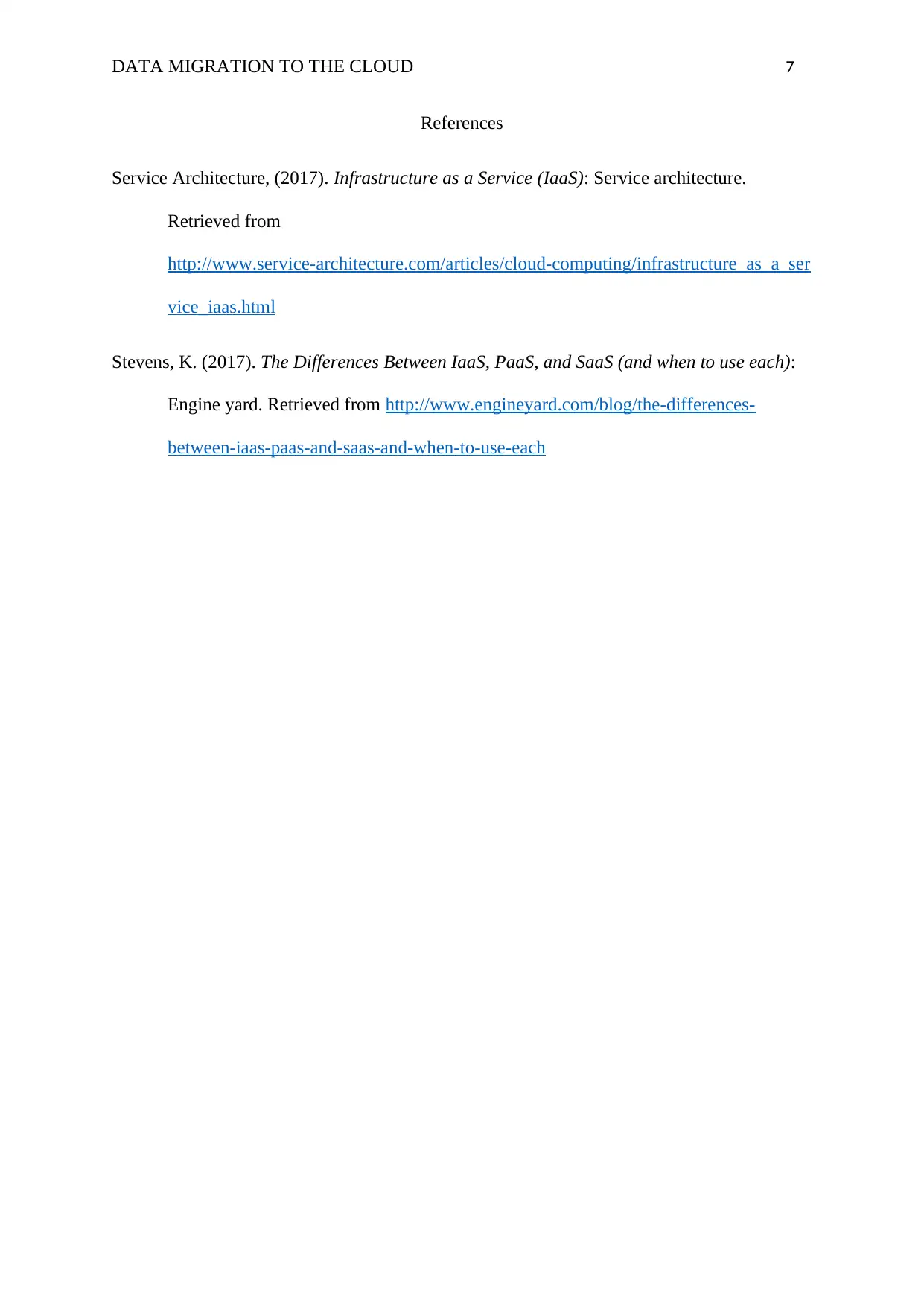
DATA MIGRATION TO THE CLOUD 7
References
Service Architecture, (2017). Infrastructure as a Service (IaaS): Service architecture.
Retrieved from
http://www.service-architecture.com/articles/cloud-computing/infrastructure_as_a_ser
vice_iaas.html
Stevens, K. (2017). The Differences Between IaaS, PaaS, and SaaS (and when to use each):
Engine yard. Retrieved from http://www.engineyard.com/blog/the-differences-
between-iaas-paas-and-saas-and-when-to-use-each
References
Service Architecture, (2017). Infrastructure as a Service (IaaS): Service architecture.
Retrieved from
http://www.service-architecture.com/articles/cloud-computing/infrastructure_as_a_ser
vice_iaas.html
Stevens, K. (2017). The Differences Between IaaS, PaaS, and SaaS (and when to use each):
Engine yard. Retrieved from http://www.engineyard.com/blog/the-differences-
between-iaas-paas-and-saas-and-when-to-use-each
1 out of 7
Related Documents
Your All-in-One AI-Powered Toolkit for Academic Success.
+13062052269
info@desklib.com
Available 24*7 on WhatsApp / Email
![[object Object]](/_next/static/media/star-bottom.7253800d.svg)
Unlock your academic potential
Copyright © 2020–2025 A2Z Services. All Rights Reserved. Developed and managed by ZUCOL.




